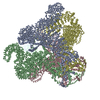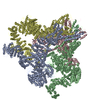[English] 日本語
 Yorodumi
Yorodumi- PDB-3jav: Structure of full-length IP3R1 channel in the apo-state determine... -
+ Open data
Open data
- Basic information
Basic information
| Entry | Database: PDB / ID: 3jav | ||||||
|---|---|---|---|---|---|---|---|
| Title | Structure of full-length IP3R1 channel in the apo-state determined by single particle cryo-EM | ||||||
 Components Components | Inositol 1,4,5-trisphosphate receptor type 1 | ||||||
 Keywords Keywords |  TRANSPORT PROTEIN / TRANSPORT PROTEIN /  inositol 1 / 4 / 5-trisphosphate receptor / calcium release channel / inositol 1 / 4 / 5-trisphosphate receptor / calcium release channel /  calcium signaling calcium signaling | ||||||
| Function / homology |  Function and homology information Function and homology informationEffects of PIP2 hydrolysis / Antigen activates B Cell Receptor (BCR) leading to generation of second messengers / inositol 1,4,5-trisphosphate receptor activity involved in regulation of postsynaptic cytosolic calcium levels / Elevation of cytosolic Ca2+ levels / cGMP effects / smooth endoplasmic reticulum membrane / platelet dense tubular network / negative regulation of calcium-mediated signaling /  calcineurin complex / platelet dense granule membrane ...Effects of PIP2 hydrolysis / Antigen activates B Cell Receptor (BCR) leading to generation of second messengers / inositol 1,4,5-trisphosphate receptor activity involved in regulation of postsynaptic cytosolic calcium levels / Elevation of cytosolic Ca2+ levels / cGMP effects / smooth endoplasmic reticulum membrane / platelet dense tubular network / negative regulation of calcium-mediated signaling / calcineurin complex / platelet dense granule membrane ...Effects of PIP2 hydrolysis / Antigen activates B Cell Receptor (BCR) leading to generation of second messengers / inositol 1,4,5-trisphosphate receptor activity involved in regulation of postsynaptic cytosolic calcium levels / Elevation of cytosolic Ca2+ levels / cGMP effects / smooth endoplasmic reticulum membrane / platelet dense tubular network / negative regulation of calcium-mediated signaling /  calcineurin complex / platelet dense granule membrane / epithelial fluid transport / ion channel modulating, G protein-coupled receptor signaling pathway / phospholipase C-activating G protein-coupled acetylcholine receptor signaling pathway / inositol 1,4,5-trisphosphate-gated calcium channel activity / regulation of postsynaptic cytosolic calcium ion concentration / voluntary musculoskeletal movement / calcineurin complex / platelet dense granule membrane / epithelial fluid transport / ion channel modulating, G protein-coupled receptor signaling pathway / phospholipase C-activating G protein-coupled acetylcholine receptor signaling pathway / inositol 1,4,5-trisphosphate-gated calcium channel activity / regulation of postsynaptic cytosolic calcium ion concentration / voluntary musculoskeletal movement /  inositol 1,4,5 trisphosphate binding / positive regulation of calcium ion transport / Glucagon-like Peptide-1 (GLP1) regulates insulin secretion / endoplasmic reticulum calcium ion homeostasis / positive regulation of hepatocyte proliferation / nuclear inner membrane / transport vesicle membrane / Ion homeostasis / dendrite development / intracellularly gated calcium channel activity / ligand-gated ion channel signaling pathway / GABA-ergic synapse / intrinsic apoptotic signaling pathway in response to endoplasmic reticulum stress / calcium channel inhibitor activity / cellular response to cAMP / release of sequestered calcium ion into cytosol / inositol 1,4,5 trisphosphate binding / positive regulation of calcium ion transport / Glucagon-like Peptide-1 (GLP1) regulates insulin secretion / endoplasmic reticulum calcium ion homeostasis / positive regulation of hepatocyte proliferation / nuclear inner membrane / transport vesicle membrane / Ion homeostasis / dendrite development / intracellularly gated calcium channel activity / ligand-gated ion channel signaling pathway / GABA-ergic synapse / intrinsic apoptotic signaling pathway in response to endoplasmic reticulum stress / calcium channel inhibitor activity / cellular response to cAMP / release of sequestered calcium ion into cytosol /  phosphatidylinositol binding / post-embryonic development / secretory granule membrane / phosphatidylinositol binding / post-embryonic development / secretory granule membrane /  sarcoplasmic reticulum / sarcoplasmic reticulum /  synaptic membrane / synaptic membrane /  liver regeneration / calcium-mediated signaling / calcium ion transmembrane transport / Schaffer collateral - CA1 synapse / cell morphogenesis / positive regulation of neuron projection development / positive regulation of insulin secretion / calcium ion transport / presynapse / liver regeneration / calcium-mediated signaling / calcium ion transmembrane transport / Schaffer collateral - CA1 synapse / cell morphogenesis / positive regulation of neuron projection development / positive regulation of insulin secretion / calcium ion transport / presynapse /  nuclear envelope / phospholipase C-activating G protein-coupled receptor signaling pathway / positive regulation of cytosolic calcium ion concentration / cellular response to hypoxia / postsynapse / nuclear envelope / phospholipase C-activating G protein-coupled receptor signaling pathway / positive regulation of cytosolic calcium ion concentration / cellular response to hypoxia / postsynapse /  protein phosphatase binding / transmembrane transporter binding / protein phosphatase binding / transmembrane transporter binding /  postsynaptic density / response to hypoxia / positive regulation of apoptotic process / protein domain specific binding / postsynaptic density / response to hypoxia / positive regulation of apoptotic process / protein domain specific binding /  dendrite / neuronal cell body / dendrite / neuronal cell body /  synapse / synapse /  calcium ion binding / protein-containing complex binding / endoplasmic reticulum membrane / calcium ion binding / protein-containing complex binding / endoplasmic reticulum membrane /  nucleolus / negative regulation of apoptotic process / perinuclear region of cytoplasm / nucleolus / negative regulation of apoptotic process / perinuclear region of cytoplasm /  endoplasmic reticulum / protein-containing complex / endoplasmic reticulum / protein-containing complex /  membrane / identical protein binding / membrane / identical protein binding /  plasma membrane / plasma membrane /  cytoplasm cytoplasmSimilarity search - Function | ||||||
| Biological species |   Rattus norvegicus (Norway rat) Rattus norvegicus (Norway rat) | ||||||
| Method |  ELECTRON MICROSCOPY / ELECTRON MICROSCOPY /  single particle reconstruction / single particle reconstruction /  cryo EM / Resolution: 4.7 Å cryo EM / Resolution: 4.7 Å | ||||||
 Authors Authors | Fan, G. / Baker, M.L. / Wang, Z. / Baker, M.R. / Sinyagovskiy, P.A. / Chiu, W. / Ludtke, S.J. / Serysheva, I.I. | ||||||
 Citation Citation |  Journal: Nature / Year: 2015 Journal: Nature / Year: 2015Title: Gating machinery of InsP3R channels revealed by electron cryomicroscopy. Authors: Guizhen Fan / Matthew L Baker / Zhao Wang / Mariah R Baker / Pavel A Sinyagovskiy / Wah Chiu / Steven J Ludtke / Irina I Serysheva /  Abstract: Inositol-1,4,5-trisphosphate receptors (InsP3Rs) are ubiquitous ion channels responsible for cytosolic Ca(2+) signalling and essential for a broad array of cellular processes ranging from contraction ...Inositol-1,4,5-trisphosphate receptors (InsP3Rs) are ubiquitous ion channels responsible for cytosolic Ca(2+) signalling and essential for a broad array of cellular processes ranging from contraction to secretion, and from proliferation to cell death. Despite decades of research on InsP3Rs, a mechanistic understanding of their structure-function relationship is lacking. Here we present the first, to our knowledge, near-atomic (4.7 Å) resolution electron cryomicroscopy structure of the tetrameric mammalian type 1 InsP3R channel in its apo-state. At this resolution, we are able to trace unambiguously ∼85% of the protein backbone, allowing us to identify the structural elements involved in gating and modulation of this 1.3-megadalton channel. Although the central Ca(2+)-conduction pathway is similar to other ion channels, including the closely related ryanodine receptor, the cytosolic carboxy termini are uniquely arranged in a left-handed α-helical bundle, directly interacting with the amino-terminal domains of adjacent subunits. This configuration suggests a molecular mechanism for allosteric regulation of channel gating by intracellular signals. | ||||||
| History |
|
- Structure visualization
Structure visualization
| Movie |
 Movie viewer Movie viewer |
|---|---|
| Structure viewer | Molecule:  Molmil Molmil Jmol/JSmol Jmol/JSmol |
- Downloads & links
Downloads & links
- Download
Download
| PDBx/mmCIF format |  3jav.cif.gz 3jav.cif.gz | 1.1 MB | Display |  PDBx/mmCIF format PDBx/mmCIF format |
|---|---|---|---|---|
| PDB format |  pdb3jav.ent.gz pdb3jav.ent.gz | 580 KB | Display |  PDB format PDB format |
| PDBx/mmJSON format |  3jav.json.gz 3jav.json.gz | Tree view |  PDBx/mmJSON format PDBx/mmJSON format | |
| Others |  Other downloads Other downloads |
-Validation report
| Arichive directory |  https://data.pdbj.org/pub/pdb/validation_reports/ja/3jav https://data.pdbj.org/pub/pdb/validation_reports/ja/3jav ftp://data.pdbj.org/pub/pdb/validation_reports/ja/3jav ftp://data.pdbj.org/pub/pdb/validation_reports/ja/3jav | HTTPS FTP |
|---|
-Related structure data
| Related structure data |  6369MC M: map data used to model this data C: citing same article ( |
|---|---|
| Similar structure data |
- Links
Links
- Assembly
Assembly
| Deposited unit | 
|
|---|---|
| 1 |
|
- Components
Components
| #1: Protein | Mass: 313657.406 Da / Num. of mol.: 4 / Source method: isolated from a natural source / Source: (natural)   Rattus norvegicus (Norway rat) / References: UniProt: P29994 Rattus norvegicus (Norway rat) / References: UniProt: P29994 |
|---|
-Experimental details
-Experiment
| Experiment | Method:  ELECTRON MICROSCOPY ELECTRON MICROSCOPY |
|---|---|
| EM experiment | Aggregation state: PARTICLE / 3D reconstruction method:  single particle reconstruction single particle reconstruction |
- Sample preparation
Sample preparation
| Component | Name: Inositol 1,4,5-trisphosphate receptor, type 1 / Type: COMPLEX / Details: homotetramer |
|---|---|
| Molecular weight | Value: 1.3 MDa / Experimental value: NO |
| Buffer solution | Name: 50 mM Tris-HCl, 0.4% CHAPS, 150 mM NaCl, 1 mM DTT, 1 mM EGTA, 1 mM EDTA pH: 7.4 Details: 50 mM Tris-HCl, 0.4% CHAPS, 150 mM NaCl, 1 mM DTT, 1 mM EGTA, 1 mM EDTA |
| Specimen | Conc.: 0.4 mg/ml / Embedding applied: NO / Shadowing applied: NO / Staining applied : NO / Vitrification applied : NO / Vitrification applied : YES : YES |
| Specimen support | Details: 400 mesh copper grids with thin carbon support |
Vitrification | Instrument: FEI VITROBOT MARK IV / Cryogen name: ETHANE / Temp: 120 K / Humidity: 100 % Details: Blot once for 3 seconds before plunging into liquid ethane (FEI VITROBOT MARK IV). Method: blot once for 3 seconds |
- Electron microscopy imaging
Electron microscopy imaging
| Experimental equipment |  Model: Tecnai Polara / Image courtesy: FEI Company |
|---|---|
| Microscopy | Model: FEI POLARA 300 / Date: Jan 1, 2014 |
| Electron gun | Electron source : :  FIELD EMISSION GUN / Accelerating voltage: 300 kV / Illumination mode: FLOOD BEAM FIELD EMISSION GUN / Accelerating voltage: 300 kV / Illumination mode: FLOOD BEAM |
| Electron lens | Mode: BRIGHT FIELD Bright-field microscopy / Nominal magnification: 23000 X / Calibrated magnification: 30886 X / Nominal defocus max: 3500 nm / Nominal defocus min: 600 nm / Cs Bright-field microscopy / Nominal magnification: 23000 X / Calibrated magnification: 30886 X / Nominal defocus max: 3500 nm / Nominal defocus min: 600 nm / Cs : 2 mm : 2 mmAstigmatism  : Objective lens astigmatism was corrected at 100,000 times magnification. : Objective lens astigmatism was corrected at 100,000 times magnification. |
| Specimen holder | Specimen holder model: GATAN LIQUID NITROGEN / Temperature: 100 K / Temperature (max): 102 K / Temperature (min): 95 K |
| Image recording | Electron dose: 22 e/Å2 / Film or detector model: GATAN K2 (4k x 4k) |
| EM imaging optics | Energyfilter name : FEI : FEI |
| Image scans | Num. digital images: 4160 |
| Radiation | Protocol: SINGLE WAVELENGTH / Monochromatic (M) / Laue (L): M / Scattering type: x-ray |
| Radiation wavelength | Relative weight: 1 |
- Processing
Processing
| EM software |
| ||||||||||||
|---|---|---|---|---|---|---|---|---|---|---|---|---|---|
CTF correction | Details: CTFFIND3 | ||||||||||||
| Symmetry | Point symmetry : C4 (4 fold cyclic : C4 (4 fold cyclic ) ) | ||||||||||||
3D reconstruction | Method: K-means clustering / Resolution: 4.7 Å / Resolution method: FSC 0.143 CUT-OFF / Num. of particles: 96106 / Nominal pixel size: 1.62 Å / Actual pixel size: 1.62 Å / Details: Applied symmetry: C4 / Symmetry type: POINT | ||||||||||||
| Refinement step | Cycle: LAST
|
 Movie
Movie Controller
Controller










 PDBj
PDBj


